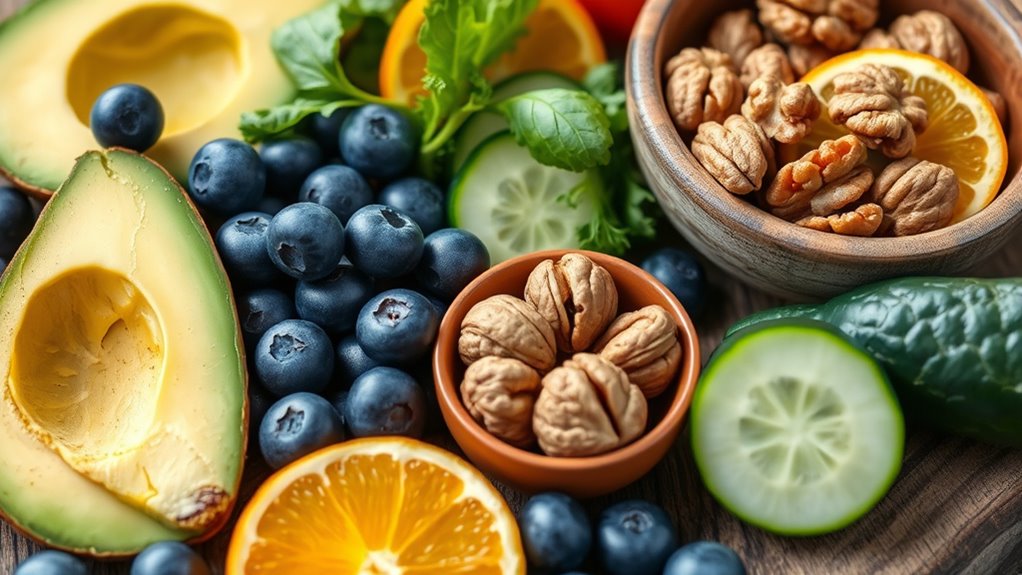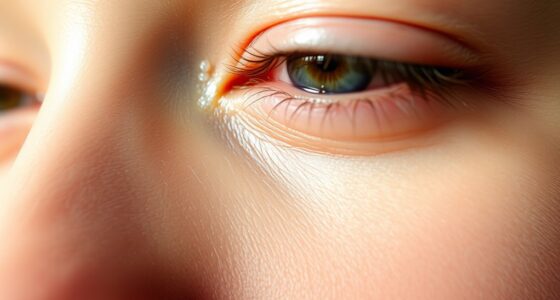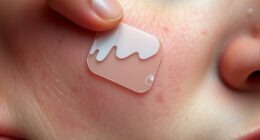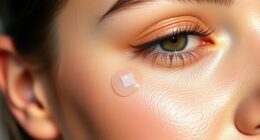To combat dry eye symptoms, incorporate omega-3 rich foods like cold-water fish, nuts, and seeds into your diet. Leafy greens boost your eye health with essential antioxidants. Don’t forget to stay hydrated by drinking plenty of water and eating water-rich foods like cucumbers and oranges. This combination enhances tear production and reduces dryness. If you’re keen to learn more about the best foods for eye moisture, there are plenty of other options to contemplate!
Key Takeaways
- Consume cold-water fish like salmon and sardines for omega-3 fatty acids, which improve tear quality and reduce dry eye symptoms.
- Incorporate leafy greens such as kale and spinach for antioxidants like lutein, which protect eyes and support tear production.
- Stay hydrated by drinking about 8 glasses of water daily, as proper hydration is essential for maintaining eye moisture.
- Include water-rich foods like cucumbers, oranges, and watermelon to enhance hydration and provide essential nutrients for eye comfort.
- Snack on nuts, especially walnuts and cashews, for their omega-3 content and vitamin E, which help reduce inflammation and support overall eye health.
Fish
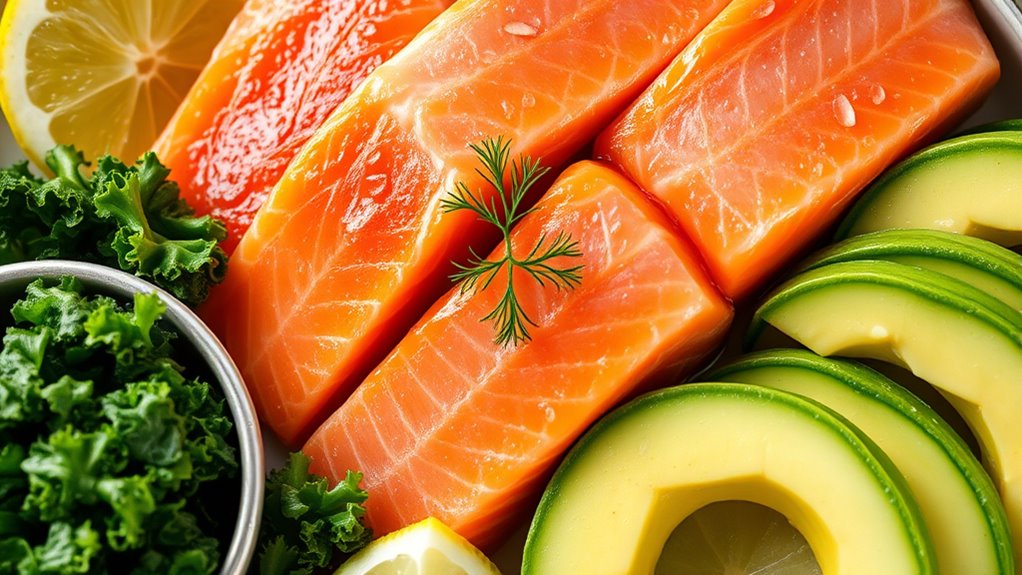
Fish is a powerhouse for your eye health, especially when it comes to combating dry eye syndrome. Cold-water fish like salmon, mackerel, and sardines are packed with omega-3 fatty acids, which help lower the risk of dry eye by stabilizing the tear film’s oil layer.
These fatty acids reduce inflammation and boost tear production from meibomian glands, crucial for maintaining healthy tears. Regularly including fatty fish in your diet can lead to improved tear quality and fewer dry eye symptoms. Additionally, consuming fish is beneficial because it is rich in antioxidants that combat oxidative stress, which can further support overall eye health. Moreover, the presence of omega-3 fatty acids in fish has been found to aid in reducing inflammation throughout the body.
If you struggle to eat fish, consider omega-3 supplements as an alternative to guarantee you get enough of these essential nutrients. Prioritizing fish in your meals is a simple yet effective way to enhance moisture and overall eye health.
Leafy Greens
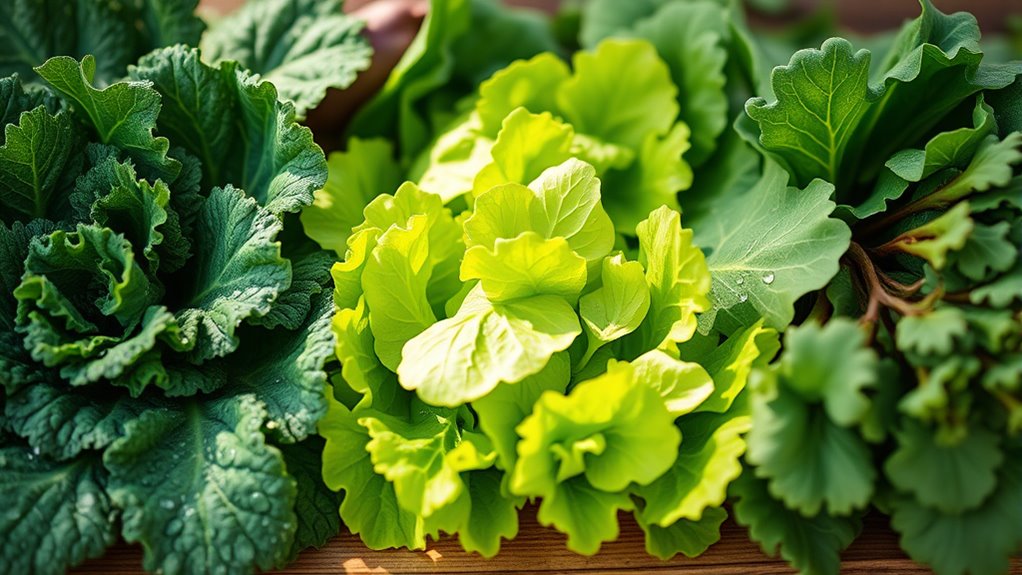
Leafy greens like kale and spinach are packed with nutrients that boost your eye health.
They contain antioxidants and vitamins that help produce tears and protect your eyes from damage.
Nutrients for Eye Health
Incorporating nutrient-rich greens like kale, collards, and spinach into your diet can greatly boost your eye health.
These leafy greens are packed with antioxidants such as lutein and zeaxanthin, which protect your eyes from harmful light and support overall vision. They’re also rich in Vitamin C, essential for maintaining healthy tear production and combating aging damage.
Additionally, folate found in these greens plays an important role in preventing vision loss and developmental issues.
Regularly consuming leafy greens enhances tear quality, helping to keep your eyes moist and reduce the risk of dry eye symptoms.
Preventing Dry Eye Symptoms
Maintaining a diet rich in nutrient-dense foods like leafy greens can greatly help in preventing dry eye symptoms.
These greens are packed with antioxidants like lutein and zeaxanthin, which protect your eyes and enhance overall eye health. Plus, their high Vitamin C content combats oxidative stress and boosts tear production, vital for hydration and comfort. Additionally, the inclusion of chia seeds in your diet can provide essential omega-3 fatty acids, which are beneficial for eye health and may help reduce hunger as part of a weight-loss strategy. Chia seeds are also a rich source of dietary fiber, which aids in digestion and overall health.
Consider incorporating a variety of leafy greens into your meals:
- Kale: Loaded with antioxidants and vitamins.
- Spinach: Supports tear film production and hydration.
- Collards: Rich in folate, essential for eye health.
- Swiss Chard: Packed with nutrients that fight dryness.
Seeds

Seeds are a powerhouse for your eye health, packed with omega-3 fatty acids that can help reduce dry eye symptoms.
Incorporating options like flaxseeds, chia seeds, and sunflower seeds into your meals not only boosts your omega-3 intake but also adds valuable nutrients like vitamin E. Additionally, chia seeds are a plant-based source of omega-3s, making them ideal for those on a vegan diet. You can also consider incorporating chia seeds into gluten-free recipes for added moisture and binding properties. Furthermore, including vegetarian diets in your lifestyle can contribute to overall well-being, which may positively impact eye health.
Omega-3 Sources
When it comes to boosting your omega-3 intake, seeds like flax, chia, and hemp are standout options. These seeds are rich in omega-3 fatty acids, which can help reduce inflammation and improve tear quality, alleviating dry eye symptoms.
Here’s how these seeds can support your eye health:
- Flaxseeds: High in alpha-linolenic acid (ALA), they enhance moisture levels and relieve dryness.
- Chia seeds: Packed with omega-3s, fiber, and antioxidants, contributing to overall hydration. Additionally, chia seeds are known for their numerous health advantages that can further support your well-being.
- Hemp seeds: Offer a balanced ratio of omega-3 to omega-6, essential for a healthy tear film.
- Incorporate a tablespoon of ground flaxseed or chia seeds into your daily diet for ideal benefits.
Additionally, a raw food diet can provide a variety of nutrients that support overall health, including eye health.
With these seeds, you’ll be well on your way to better eye health!
Nutritional Benefits
While incorporating seeds into your diet, you’ll discover a wealth of nutritional benefits that can greatly enhance your eye health.
Seeds, especially flaxseeds, chia seeds, and hemp seeds, are rich in omega-3 fatty acids, essential for maintaining tear film stability and reducing inflammation associated with dry eyes. They also provide vitamin E, an antioxidant that protects your eye cells from oxidative damage, further supporting overall eye health.
Adding seeds to your meals can boost your omega-3 intake alongside fatty fish, promoting moisture for your eyes. If you’re vegetarian or vegan, flaxseed oil is an excellent alternative.
Don’t forget varieties like sunflower and pumpkin seeds, which offer zinc and magnesium, additional nutrients that contribute to ideal eye health.
Nuts

Nuts are a powerhouse of nutrients that can greatly benefit your eye health, especially if you’re struggling with dry eyes. They’re rich in omega-3 fatty acids, which help reduce inflammation and support tear production essential for eye comfort.
Including nuts in your diet can alleviate dry eye symptoms and enhance moisture levels.
- Walnuts and cashews are particularly high in omega-3s.
- Vitamin E acts as a potent antioxidant, protecting eye cells.
- A handful of mixed nuts daily can boost overall eye health.
- Peanuts, while legumes, offer similar omega-3 benefits.
Regularly enjoying nuts can improve the quality of your tears, ensuring your eyes stay comfortable and hydrated.
Beans

Incorporating beans into your diet can greatly boost your eye health, especially if you’re dealing with dry eyes. Beans are packed with essential nutrients, including B vitamins and zinc, which are essential for the absorption of vitamin A by your retina. This helps protect your eyes from light damage and supports overall eye health.
Varieties like black-eyed peas, kidney beans, and lima beans serve as nutritious meat substitutes and enhance your fiber intake. The zinc in beans plays a significant role in melanin production, shielding your eyes from harmful light and potentially alleviating dry eye symptoms.
Water

Staying hydrated is essential for your eye health, especially if you’re prone to dry eyes. Water plays a vital role in producing tears, which are about 98% water. When you’re dehydrated, your eyes can suffer, leading to discomfort.
Staying hydrated is crucial for eye health, particularly for those with dry eyes, as dehydration can lead to discomfort.
To maintain ideal eye moisture, aim for a daily intake of about 8 glasses of water. Additionally, consider incorporating water-rich foods into your diet:
- Cucumbers
- Oranges
- Spinach
- Watermelon
These fruits and vegetables not only support hydration but also contribute to your overall health.
Frequently Asked Questions
What to Eat to Reduce Eye Dryness?
To reduce eye dryness, you should focus on incorporating omega-3 fatty acids into your meals.
Eat cold-water fish like salmon and sardines, and include nuts and seeds like walnuts and flaxseeds.
Load up on leafy greens such as spinach and kale for antioxidants, and don’t forget your colorful veggies like sweet potatoes and carrots for vitamin A.
Staying hydrated is essential, so drink plenty of water daily to keep your eyes moist and comfortable.
How Can I Increase Moisture in My Eyes?
Imagine your eyes as parched deserts, craving a deluge of moisture! To quench that thirst, start by drinking plenty of water—your tears are mostly made of it!
Then, plunge into a feast of fatty fish, leafy greens, and nuts. These delicious foods aren’t just tasty; they’ll supercharge your tear production and keep your eyes feeling fresh.
Don’t forget citrus fruits for a zesty hydration boost—your eyes will thank you!
Which Fruit Is a Miracle for Eyesight?
You might find blueberries to be a miracle for your eyesight. Packed with anthocyanins, these little berries serve as powerful antioxidants that can enhance your vision and protect against eye diseases.
Incorporating them into your diet can be a delicious way to boost your eye health. Don’t forget about other fruits like citrus and kiwi, which also offer essential nutrients to keep your eyes sharp and healthy.
Enjoy a colorful variety!
What Vitamin Keeps Eyes Moist?
You might think vitamins are just for overall health, but they’re essential for your eyes, too!
The vitamin that keeps your eyes moist is Vitamin A. It helps produce and maintain the tear film, which keeps your eyes lubricated. Without enough Vitamin A, you risk dry eyes.
Incorporate foods like carrots, sweet potatoes, and dark leafy greens into your diet to guarantee your eyes stay healthy and moist. Your eyes will thank you!
Conclusion
To keep your eyes moist and combat dry eye symptoms, it’s important to incorporate the right foods into your diet. By including fish, leafy greens, seeds, nuts, and beans, you’re not just eating for your eyes but for your overall health. Remember, you are what you eat—so choose wisely! And don’t forget to stay hydrated with plenty of water. With these dietary changes, you’ll be well on your way to brighter, more comfortable eyes.
